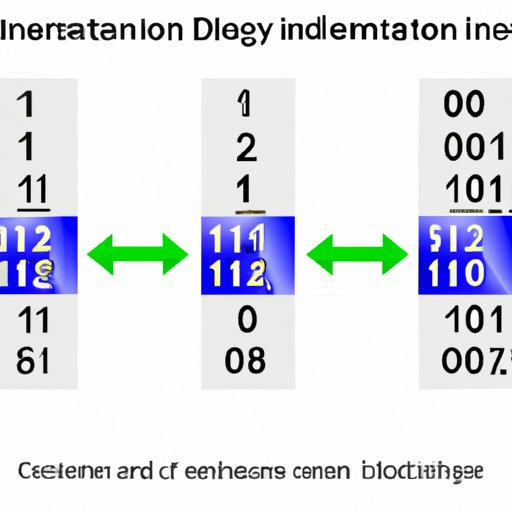
I. Introduction
The binary and decimal systems are two of the most fundamental number systems. Binary, which is also known as base-2 system, is widely used in computing and digital electronics. Decimal, on the other hand, is the base-10 system used in everyday life. The ability to convert decimal to binary is an important skill, particularly for programmers. In this article, we will cover the basics of decimal to binary conversion, step-by-step guides, real-world applications, and online tools that can help simplify the process.
II. Basic Concept and Conversion
Binary and decimal systems are different in the way they express numbers. The decimal system represents numbers using ten digits, i.e., 0 to 9, and a place value system. The binary system, on the other hand, uses only two digits, 0 and 1, to represent numbers. In decimal system, each position to the left of the decimal point represents an increasing power of 10, whereas in the binary system, each position to the left of the binary point represents an increasing power of 2. To convert decimal to binary, we need to understand the basic concept of binary numbers and the conversion process.

III. Understanding the Decimal to Binary Conversion
The process of converting decimal to binary involves a series of steps. First, we need to divide the decimal number by 2, and then note down the remainder. Then we divide the quotient again by 2, note down the remainder, and repeat this process until the quotient becomes zero. We read the remainders from bottom to top to get the corresponding binary digits. The place values of binary digits are also important when converting decimal to binary.
For example, to convert 13 to binary, we divide 13 by 2, which gives us a quotient of 6 and a remainder of 1. We then divide 6 by 2, which gives us a quotient of 3 and a remainder of 0. We repeat the process and obtain remainders of 1, 1, and 0, respectively. Writing down these remainders from bottom to top, we get 1101. Therefore, 13 in decimal is equivalent to 1101 in binary.
When dealing with decimal numbers that have a fraction component, we can use a similar conversion process. However, instead of dividing by 2, we multiply the fractional part by 2 and note down the integer component. This process is repeated until the fractional part becomes zero.
IV. Converting Decimal to Binary Manually
Converting decimal to binary manually can be challenging, but with practice, it becomes easier. First, we need to write down the decimal number and the binary number system. Then, we divide the decimal number by 2 and write down the result and the remainder. We repeat the process with the quotient until the quotient becomes zero. Finally, we write down the remainders in reverse order to get the binary equivalent.
For example, to convert 27 to binary, the process is as follows:
The remainders are read from the bottom to the top to get the binary equivalent, which is 11011.
Examples and exercises are great ways to improve manual conversion skills.
V. Benefits of Learning Decimal to Binary Conversion for Programming
Binary is the language of computing and digital electronics, and it plays a vital role in programming. Being able to convert decimal to binary is an essential skill for programmers. In programming, binary values are used to represent machine-level instructions and data. Understanding binary code also enables programmers to optimize code and improve performance.
For example, consider the decimal number 42. Its binary equivalent is 101010, which uses only six digits. This means that we can store this number using six bits instead of the eight bits required in the decimal system. This optimization leads to smaller storage requirements and faster processing times.
Real-world applications of binary code include communication devices, digital clocks, computers, and smartphones.
VI. Quick and Easy Decimal to Binary Conversion using Online Tools and Calculators
There are many online tools and calculators that can help simplify decimal to binary conversion. These tools are particularly useful when dealing with large or complex decimal numbers. A popular tool is the Decimal to Binary Converter by RapidTables. To use this tool, simply enter the decimal number in the input box, and the binary equivalent will be displayed instantly.
VII. Avoiding Common Mistakes while Converting Decimal to Binary
Converting decimal to binary can be tricky, and it is common to make mistakes, especially with manual conversion. One common mistake is to forget to divide the quotient and write down the remainder. Another mistake is to write down the binary digits in the wrong order. To avoid these mistakes, always double-check your work and practice regularly.
VIII. Real-Life Applications of Binary Code in Technology and How to Convert Decimal to Binary to Leverage these Applications
Binary code has numerous real-life applications in technology. For example, in digital photography, binary code is used to represent pixel data. In addition, binary code is used to represent ASCII characters, which are widely used in text-based communication.
To convert decimal to binary for these applications, the process is the same as in the earlier examples. Once you have the binary equivalent, you can then use this information in the specific application.
IX. Conclusion
In conclusion, decimal to binary conversion is an essential skill, particularly for programmers. In this article, we have covered the basic concepts of decimal and binary systems, the step-by-step process of converting decimal to binary, and how to avoid common mistakes. We have also explored the importance of understanding binary code in programming and real-world applications. Whether you are a beginner or an experienced programmer, mastering decimal to binary conversion is highly beneficial and improves problem-solving skills. Practice and using online tools can help anyone improve their conversion skills.





